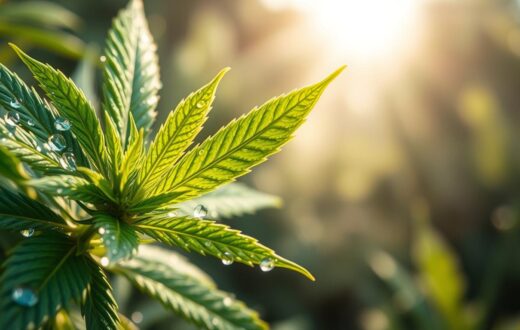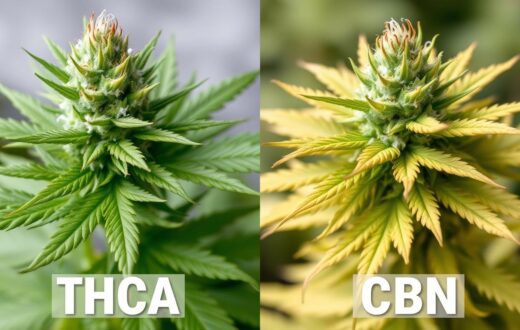Ever wondered why some cannabis strains are more potent than others? It’s not just THC, the psychoactive compound we know. There’s another key player: THCA.
THCA, or tetrahydrocannabinolic acid, is THC’s precursor. It’s in raw cannabis and doesn’t get you high. Yet, its content by strain can greatly affect cannabis potency when heated.
Let’s explore cannabinoids and how THCA influences the cannabis experience. We’ll see how different strains compare in THCA content. This is important for both medical and recreational users.
THCA is crucial for understanding cannabis potency. While THC gets all the attention, THCA is just as important. It makes up about half of the non-psychoactive cannabinoids in most raw strains. It’s time to recognize THCA’s role.
Ready to become a cannabis expert? Let’s dive into the world of THCA and its variations across strains. Get ready for an enlightening journey!
Introduction to THCA and Its Importance
Cannabis is full of fascinating compounds, with over 500 cannabinoids found in it. Tetrahydrocannabinolic acid (THCA) is a key player, found in raw cannabis. Unlike THC, THCA doesn’t make you feel high. Let’s explore why THCA is important.
What is THCA?
THCA is a cannabinoid with the chemical formula C22H30O4. It’s the precursor to THC, the psychoactive part of cannabis. THCA is found in fresh, raw cannabis plants. It doesn’t bind to the same receptors in our bodies as THC, so it won’t get you high.
How THCA Differs from THC
THCA and THC have different effects on the body. THCA is non-psychoactive, while THC makes you feel intoxicated. THCA turns into THC when cannabis is heated or exposed to light. This is why smoking or vaping cannabis gets you high, but eating raw cannabis doesn’t.
Why THCA Content Matters
THCA content is important for both recreational and medical users. For those looking for THC’s effects, knowing the THCA content helps predict the outcome after heating. On the medical side, THCA might have anti-inflammatory and neuroprotective properties. It could help with conditions like epilepsy and multiple sclerosis, but more research is needed.
Overview of Cannabis Strains
Cannabis strains are mainly divided into three types: indica, sativa, and hybrid. Each type has its own unique traits. These traits influence how they grow and the effects they have on users.
Indica vs. Sativa vs. Hybrid
Indica strains are known for their relaxing effects. They have broader leaves and shorter flowering cycles. Sativa strains, on the other hand, are more energizing. They have narrower leaves and longer flowering periods.
Hybrid strains combine traits from both indica and sativa. They offer a balanced effect.
Popular Strains and Their Characteristics
High-THCA strains like Gorilla Glue, OG Kush, and Sour Diesel are well-known. They are prized for their potency and potential health benefits. For example, Secret Nature’s Blood Diamond strain has 25.4% THCA. Their Jetfuel strain has 24.7% THCA, both with less than 0.3% THC.
Hybrid strains are often chosen for pain relief. A 2018 U.S. survey found hybrids were the most popular choice for pain. Indica strains are also effective in reducing insomnia symptoms, more so than sativa or CBD-dominant strains.
How to Measure THCA Content
Cannabis testing is key to knowing how strong marijuana products are. It helps users make smart choices about their cannabis. Let’s dive into how to measure THCA content and why it’s important.
Understanding Laboratory Tests
Cannabis labs use advanced methods to check thc content. Gas Chromatography (GC) and Liquid Chromatography (LC) are common for analyzing cannabinoids. These tests break down and measure different compounds in cannabis, showing exact THCA levels.
Reading THCA Reports
In a lab report, you’ll see THCA percentages. To figure out the potential THC after heating, multiply the THCA percentage by 0.877. For instance, if a strain has 20% THCA, it could have about 17.5% THC when smoked or vaped. This helps you know the real strength of your cannabis.
The Importance of Accurate Testing
Accurate lab tests ensure product safety and meet legal standards. They help users dose right and avoid surprises. It’s crucial for medical users who need specific levels. Reliable testing also builds trust in the industry and supports research into cannabis benefits.
High-THCA Strains Overview
High thc strains are becoming more popular among cannabis fans. These strains have high levels of THCA, making them very potent. Let’s dive into the world of high-THCA strains and what makes them special.
The Characteristics of High-THCA Strains
High-THCA strains have 15% or more THCA. The White Truffle strain by Secret Nature has an amazing 28.3% THCA. Other top strains include Tropical Cherry (25.5%) and Jetfuel (24.9%). They come in different flavors, like fruity and sweet, or earthy and gas-like.
Benefits of High-THCA Strains
People love high-THCA strains for their health benefits and strong effects. When heated, these strains can offer strong relief for many issues. The Strawberry Mimosa strain, with 23.97% THCA, is a favorite among sativa fans. Arete’s White Widow strain has a huge 33.9% THCA content for those seeking the strongest effects. Remember, each strain is unique, so pick what suits you best.
Low-THCA Strains Overview
Low thc strains are becoming more popular. They have less than 15% THCA. This makes them perfect for beginners or those who are sensitive to THC. Let’s look at what makes these strains special and their uses.
Characteristics of Low-THCA Strains
These strains often have more CBD, which offers different health benefits. ACDC is a high CBD strain with little THC. It’s great for those who want relief without feeling too high. Cannatonic has a mix of CBD and THC, offering a balanced effect. Lifter is also popular, with low THC and lots of CBD.
Uses for Low-THCA Strains
These strains are versatile and have many uses. They’re perfect for daytime use because they help you stay focused. Medical users like them for specific benefits without a strong high.
Sour Diesel has a 1:1 THC-to-CBD ratio, offering a gentle experience. Blue Dream has a 1:2 CBD-THC ratio, providing a mild, relaxing effect. These strains are great for those who want cannabis benefits without feeling overwhelmed.
Comparing THCA Levels Across Strains
Cannabis strain comparison shows a wide range of THCA percentages. THCA flowers can have up to 40% THCA. When smoked, about 87.7% of this converts to THC. This variation affects the potency and effects of different strains.
Top Cannabis Strains with High THCA Levels
High-THCA strains have 15% or more THCA. These strains have dense trichomes, leading to higher THCA levels. Popular strains like Gorilla Glue, OG Kush, and Bruce Banner are known for their intense effects.
Strains with Moderate THCA Content
Moderate-THCA strains have 10-15% THCA. These strains offer a balance between potency and manageability. They’re great for users who want noticeable effects without being too intense. Many hybrid strains fall into this category, providing relaxation and mental clarity.
Strains with Low THCA Content
Low-THCA strains have less than 10% THCA and may have more CBD. These strains are perfect for beginners or those who prefer milder effects. Some are bred for their CBD content, offering therapeutic benefits without strong psychoactive effects. The Farm Bill of 2018 allows hemp products with 0.3% or less THC, opening new markets for low-THCA cannabis products.
Factors Influencing THCA Content
THCA levels in cannabis plants depend on several factors. How you grow cannabis greatly affects the THCA content. Growers need to focus on the environment and growing techniques to increase THCA.
Growing Conditions Impacting THCA
Light, temperature, and humidity are key to THCA production. The right growing conditions can increase THCA levels. But, bad conditions can lower it.
Soil quality and nutrients are also crucial. After harvesting, drying and curing properly helps keep THCA levels high.
Genetics and THCA Production
Marijuana genetics are very important for THCA levels. Some strains naturally have more THCA. Breeders work to create strains with high THCA content.
Choosing the right strain is key for the THCA level you want. Indica, sativa, and hybrid strains have different THCA levels, usually between 15% and 30%. Terpenes also affect THCA production, sometimes helping, sometimes not.
Knowing these factors helps growers get the most THCA from their plants.
The Role of Terpenes in Cannabis Strains
Cannabis terpenes are key in defining different marijuana strains. They add to the unique flavors and scents of cannabis. Each strain has its own terpene mix, affecting its aroma, color, and taste.
How Terpenes Affect THCA Levels
Terpenes don’t change THCA levels directly. But, they work with cannabinoids to create the entourage effect. This mix enhances the cannabis experience. For instance, myrcene might help cannabinoids like THCA get absorbed better.
Popular Terpenes in High-THCA Strains
High-THCA strains have a blend of strong terpenes. Limonene, with its citrus smell, boosts mood. Pinene, smelling like pine, fights inflammation. β-Caryophyllene, with its earthy scent, helps with pain.
Terpenes like linalool and humulene also play a part. They mix to give each strain its own aroma and benefits.
Medical Applications of THCA
THCA is a key part of medicinal cannabis with promising benefits. As research grows, we’re finding new uses for it in marijuana therapy.
Potential Health Benefits
THCA has anti-inflammatory properties that could help with arthritis and inflammatory bowel disease. It also has neuroprotective effects, which might help with Parkinson’s and Alzheimer’s. Plus, it acts as an antioxidant, protecting cells from damage.
Conditions Treated with THCA
THCA might help with chronic pain and reduce nausea, especially for those undergoing chemotherapy. Doctors have seen positive results using raw cannabis with THCA for different treatments. It’s key to remember that THCA doesn’t get you high when consumed raw, unlike THC.
While THCA looks promising, more research is needed. Always talk to a healthcare professional before starting any marijuana therapy. Also, the legal status of THCA varies by state, so check local laws before using it.
Legal Aspects of THCA in the United States
THCA is in a complex legal spot in the U.S. Laws on cannabis vary by state, making a mix of rules. Some states are more open, while others are strict about thca rules.
Understanding State Laws
State laws on THCA are all over the place. California and Colorado let you buy THCA flower freely. But Texas limits products that could become psychoactive THC. Pennsylvania has its own rules for hemp-derived cannabinoids.
Federal Regulations on Cannabis
Federal law is clear on hemp products with less than 0.3% THC. THCA isn’t psychoactive on its own but turns into THC when heated. This makes its legal status tricky.
The DEA says tetrahydrocannabinols, including THCA, are Schedule I substances. But the 2018 Farm Bill made low-THC hemp products legal. This leaves THCA’s legal status up in the air.
Some say THCA is legal since it doesn’t have THC in its raw form. Others worry about its potential to become THC. Lawmakers are looking to change cannabis laws and hemp product rules. This shows how cannabis laws in the U.S. are always changing.
THCA and Consumer Preferences
Cannabis consumer trends are shifting towards THCA content in strain choices. As marijuana preferences change, users now understand the difference between THCA and THC. This knowledge influences their picks in the growing cannabis market.
Trends Among Cannabis Users
Many cannabis fans look for high-THCA strains for their potency after decarboxylation. This conversion turns THCA into THC, which causes the high. Yet, some prefer strains with less THCA for a milder effect.
There’s also a trend towards raw cannabis products rich in THCA. These are consumed for health benefits without the high.
Influencing Factors in Strain Selection
Choosing a strain depends on several factors. Users consider the desired high, medical benefits, and flavor. Personal tolerance is also key.
As the cannabis industry grows, consumers are getting more picky. This leads to a wider range of marijuana preferences and trends.
Knowing about THCA content is crucial in picking strains. Users see that THCA doesn’t get you high until heated. This lets them choose how they want to use cannabis, based on their needs.
The Future of THCA Research
Cannabis research is moving fast, with THCA studies leading the way. We’re learning more about this non-psychoactive compound. This is shaping the future of cannabis medicine.
Ongoing Studies on THCA
Scientists are looking into THCA’s health benefits. In 2023, THCA sales hit $200 million, making up 7.3% of hemp product sales. This growth is pushing research forward.
Potential Discoveries in Cannabis Science
Research on THCA is showing promising results. It might help with inflammation, like in arthritis. It could also protect the brain, helping with neurodegenerative diseases.
The cannabis industry is moving towards balanced compounds, not just THC. This matches the focus on THCA’s safety and natural makeup. As research goes on, we’ll see new products and treatments using THCA and other compounds.
Conclusion: Choosing the Right Strain
Choosing the perfect cannabis strain is more than just looking at THCA content. It’s about finding the right balance for your needs. Our cannabis strain guide aims to help you make informed decisions in your marijuana selection journey.
Evaluating THCA Content for Individual Needs
When considering THCA levels, it’s crucial to understand how they translate to effects. For instance, Area 52’s Lemon Cherry strain and Finest Labs’ products dipped in THCA diamonds offer high potency options. Hemp Generation’s Cherry Milkshake, with 24.41% THCA, provides a robust experience. These THCA considerations can guide you towards strains that match your desired intensity.
Final Thoughts on Cannabis Strain Selection
Remember, strain selection goes beyond THCA. Factors like terpene profiles, CBD content, and desired effects play significant roles. Indica strains like those from Secret Nature might be ideal for relaxation, while sativa-dominant options could boost energy. Hybrids offer a middle ground. Don’t forget to consider aroma and flavor – Arete Hemp’s Sour Patch Kidz, for example, delivers both potency and unique taste profiles.
Ultimately, finding your perfect strain may require some experimentation. Keep a strain journal, start with lower potencies, and always prioritize products from reputable sources with clear lab testing. By considering all these factors, you’ll be well-equipped to navigate the diverse world of cannabis strains and find the ones that work best for you.















